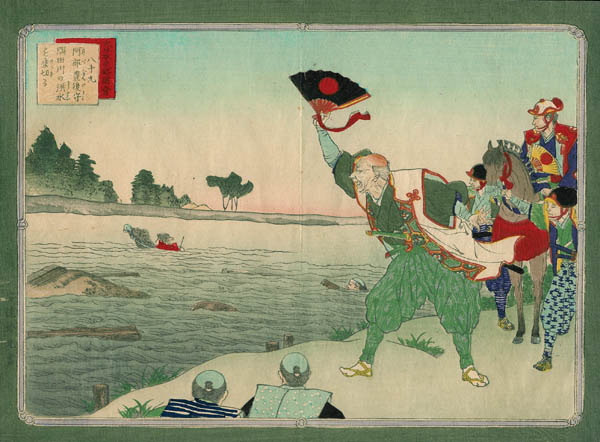| Title: |
Abe Bungo, on Horseback, Crossing the Sumida River |
| Artist: |
Ginko (Japan, fl., 1874 - 1899) |
| Date: |
March 01, 1898 |
| Medium: |
Original Japanese Woodcut |
| Publisher: |
Matsuki Heikichi |
| Source: |
Great Japanese History Illustrated |
| Note: |
As little as fifty years ago, the trend with some Japanese
art collectors was to reject the woodcuts of the Meiji era between (1868 & 1912)
as being garish and unrefined. The introduction of Western pigments and
styles and techniques (c. 1865) created a dynamic revolution in Japanese
art. Bold new colour patterns and equally bold design concepts began to
dominate the classic woodcut. Yet, far from ruining traditional art forms,
Meiji era artists injected a vital force into the woodcut by amalgamating
Japanese and Western concepts. The great masters of this time -- Yoshitoshi,
Ginko, Chikanobu and others -- thus created a number of strikingly original
images which contemporary scholars and collectors now favourably compare
with the art of earlier nineteenth century woodcut artists. |
| |
A noted innovator, Ginko filled a dual role during the Sino-Japanese
War as both an illustrator and a war correspondent. Stylistically he bears
similarities to Yoshitoshi, and probably Ginko studied under this master.
Ginko's most striking art is found in the series of one hundred woodcuts
which comprise, "Great Japanese History Illustrated", of which this
original woodcut entitled, "Abe Bungo, on Horseback, Crossing the Sumida River"
is a fine example. This series depicted the great events of Japanese history
and folklore and was published in ten folding portfolios during 1897 and
1898. The woodcuts achieved great critical recognition and even received
an official award from the Japanese government. Displaying a complex range
of colours and design elements, these original woodcuts stand as one of
the finest accomplishments of Meiji era art. |
| |
Abe Bugo-no-kami was the rank held by several members of the Abe family (clan). Here, Ginko depicts the retainer of Abe Bungo-no-kami, Hirata Danemon Tachibana Kiyotsune, a man of sixty-eight battling the raging waters as he crosses the Sumida river on horseback to establish how much damage was caused by the great flood of 1632 which overflowed their banks. The Komadome Inari shrine (a shinto shrine to worship the god Inari), was build to commemorate and show gratitude for the heroic deed of
Abe Bungo around the late 17th century. Another version of this story says that the young Tadaaki Abe was the hero who volunteered to measure the damage. This Japanese woodcut is a striking example of Ginko's landscape and Meiji era art. Yoshitoshi created another woodcut which depicts the river crossing with Abe Bugo-no-kami, entitled, Kozui (Flood), published for his series entitled, Seiu kandankei (Barometer of Emotions) published in 1876. An original woodcut, Abe Bungo, on Horseback, Crossing the Sumida River hails from the Great Japanese History Illustrated. It is a striking example of the Meiji art created by the Japanese artist, Ginko. |
| Size: |
7 X 9 1/2 (Sizes in inches are approximate,
height preceding width of plate-mark or image.) |
| |
Matted with 100% Archival Materials |
| Buy Now |
Price: $395.00 US |
| Condition: |
Printed upon hand-made, nineteenth century Japanese mulberry paper and with full margins as published in 1898. A splendidly printed impression from the first and only edition and in excellent condition throughout. Altogether, "Abe Bungo, on Horseback, Crossing the Sumida River (Great Japanese History Illustrated)", represents a stunning and important original example of Ginko's fine art. |
| |
Each woodcut in this series was published with a printed
sheet describing the history of the event portrayed. This is included
with the documentation. |
| Important Information: |
The artist biographies, research and or information pertaining to all the original works of art posted on our pages has been written and designed by Greg & Connie Peters exclusively for our site, (www.artoftheprint.com). Please visit us regularly to view the latest artworks offered for sale. We will soon be posting an update of our most recent research and include the biographical and historical information pertaining to our next collection of original works of art created by artists throughout the centuries. We hope you found the information you were looking for and that it has been beneficial.
Our Gallery, (Art of the Print / www.artoftheprint.com) guarantees the authenticity of every work of art we sell 100%. Full documentation and certification is provided. We offer a wide selection of international fine art dating from the early Renaissance to the contemporary art period. |







![]()
![]() or
phone Greg & Connie (905) 957-6666
or
phone Greg & Connie (905) 957-6666